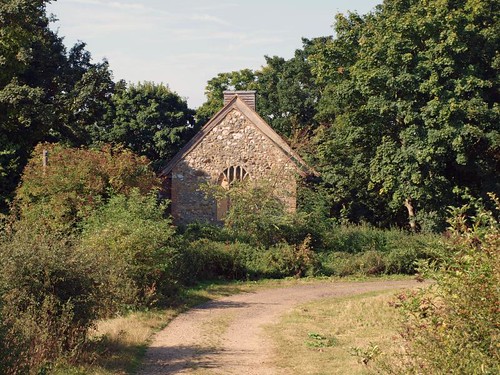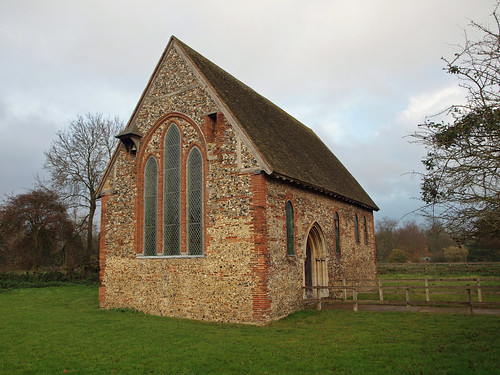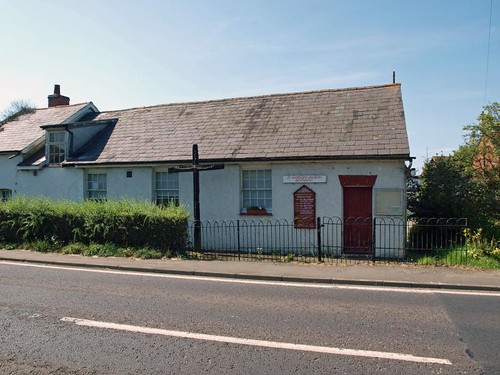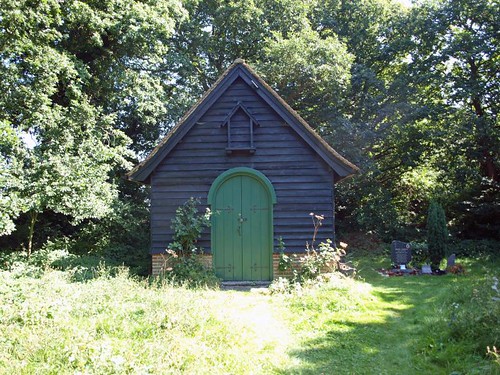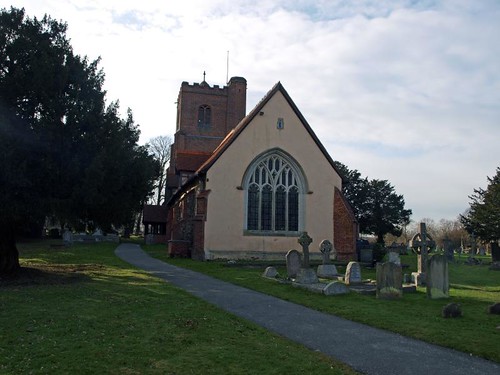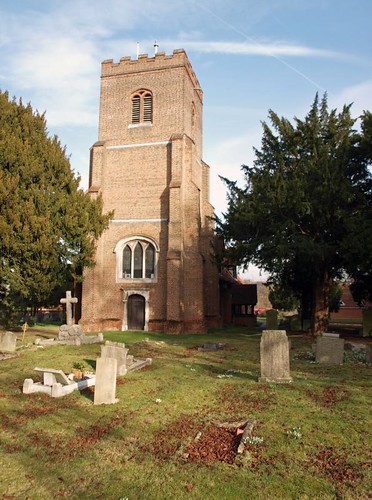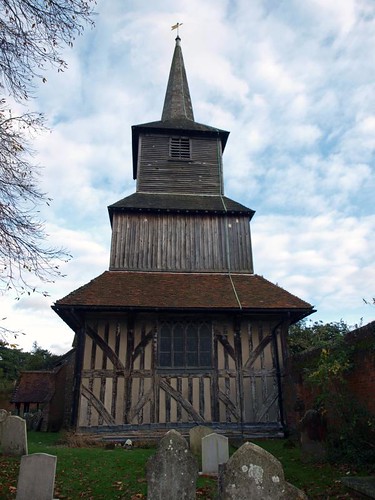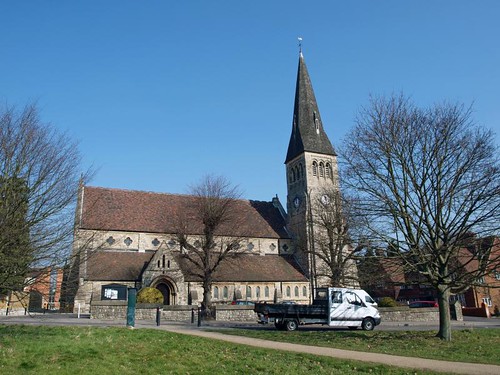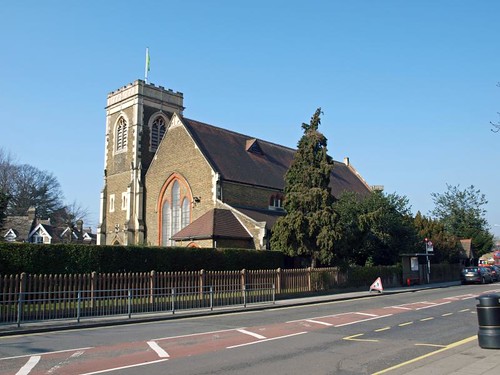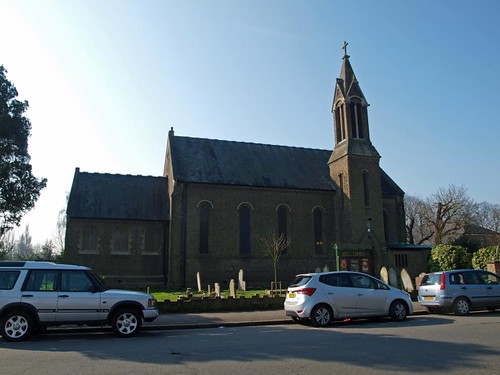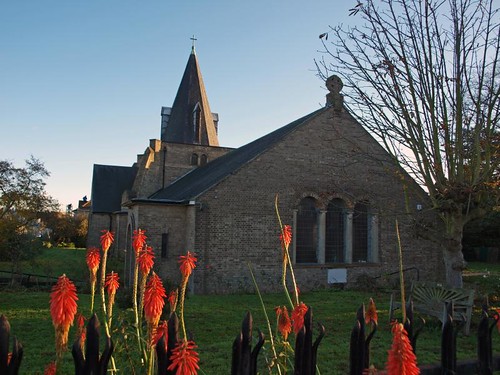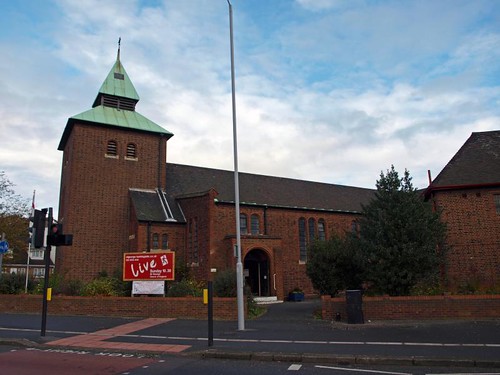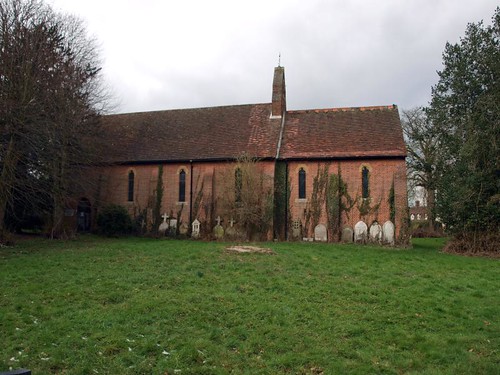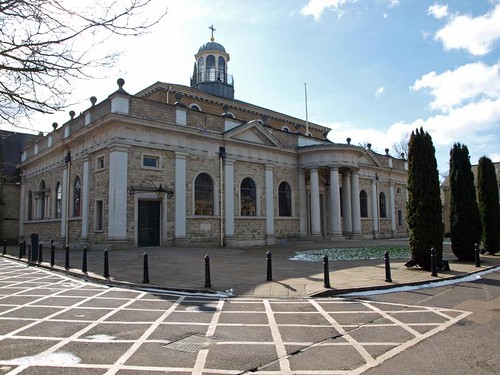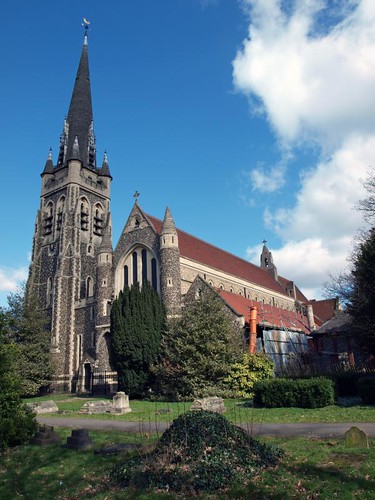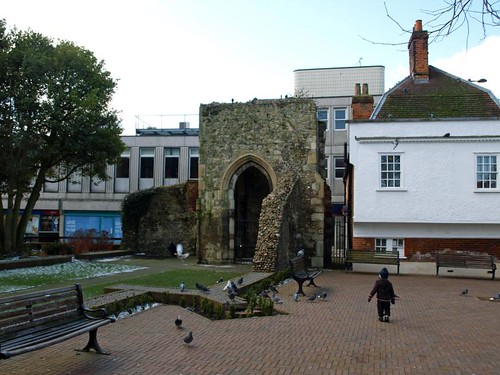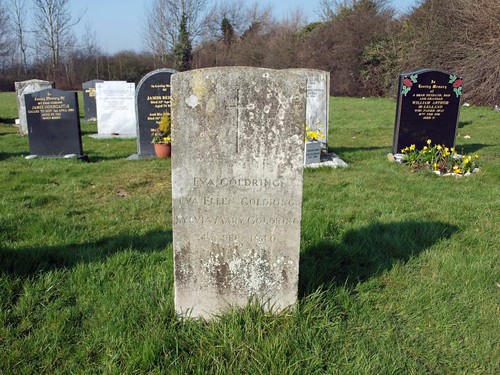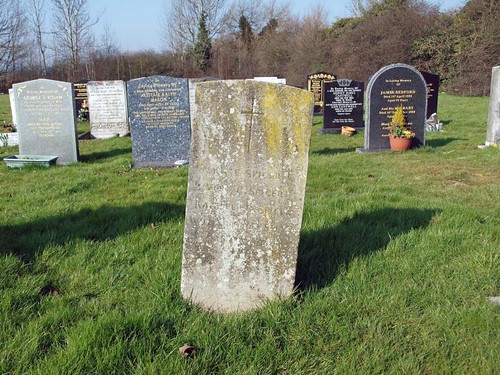WALTHAM ABBEY is no more than a fragment of what it was: a Norman nave, a C14 chapel, a C14 W wall, and a C16 W tower.At the E end at least two thirds of the building have gone, and nearly all the monastic buildings have gone. The abbey was founded in 1030 as a collegiate church of secular canons. It was built or rebuilt with some pomp by Harold and consecrated in 1060. We have no date after that, until we come to 1177, the re-foundation as an abbey of Augustinian Canons In 1184 it was given the dignity of a ‘mitred abbey’, and it soon became one of the most prosperous and important abbeys e in the country. It is teasing for the historian that for the main part of the surviving building no dates exist to guide him. In addition, until 1938, no guidance existed either as to the extent and character of the work which followed the re-foundation of 1177. The extent is now known, though not yet the character. The one is due to excavations carried out in 1938-9, the other to their limited scope. The Early English abbey meant the addition to the Norman nave and crossing of a whole church, that is a choir longer than the Norman nave, an E transept bigger than the Norman transept and a long and large retrochoir. It must have dwarfed the Norman parts completely, and may have looked something like Canterbury Cathedral before the nave was rebuilt in the C14. But we do not know the style of 1177 etc. at Waltham. The E parts of the abbey were pulled down after the Dissolution.
The Norman crossing which had been left standing in 1177 was then also pulled down. So all that survives of Norman architecture is nave and aisles, a nave, no more than seven bays long. It seems, except for C14 adjustments at the W end and C19 adjustments at the E end, to be all of a piece, but reveals to the attentive observer many puzzling irregularities. The present E wall is an infilling of the CI9 across the W arch of the crossing and the aisle arches into the transepts. This is clearly visible from the outside, where also one S transept W window can be noticed, which now leads into the C14 chapel (see below). Below it is exposed coarse rubble masonry, laid herringbone-wise.
The exterior of the nave is simple: aisle windows with nook-shafts, circular gallery windows, and clerestory windows with nook-shafts and some zigzag decoration - all much renewed. The Norman S doorway of two orders, with an upcurved lintel and zigzag in the arches is in its surface, it seems, wholly C19. The inside is much more impressive. It has something of the sturdy force of Durham Cathedral, though neither its size nor its proportions. The system of elevation which applies throughout is that of nearly all major Anglo-Norman churches: arcade-gallery-clerestory. It is baffling, though only for a moment, that the gallery is deprived of its floor so that the aisles are now much higher than they were meant to appear. The arcades have supports alternating between superordinate composite piers, and subordinate round ones. The gallery openings are large and un-subdivided. The clerestory has the usual English arrangement of a wall-passage and, towards the nave, an arcade of three arches for each bay, with the middle arch wider and taller.
In detail the most striking of all features of Waltham is the deeply grooved circular piers - a detail familiar from Durham, and also from Norwich, nearer Waltham. These piers are spiral-grooved in the first circular pair from the E, zigzag grooved in the second, and left plain in the third. The composite piers have a buttress-like broad flat projection to the nave with a demi-shaft attached, and this projection with its shaft runs up to the ceiling without any break. The capitals are big and heavy, single- or double-scalloped. Above the first circular pier from the E they project a little more boldly than above the others. These first circular piers have also different bases, and the E respond (as also the E arch of the S aisle), is different in one detail from the W responds. Of the four capitals of the three respond shafts, the middle one is a little deeper on the E side. In the arches a difference of a similar nature can be detected. The arches have all zigzag ornamentation on the faces, but in the E ones the inner zigzag goes fairly deeply into the soffits as well - again a sign of a bolder, more three-dimensional treatment. It finds its parallel in the W crossing arch high up.* Again, looking at the arcade from the aisles, it will be noticed that in the W parts each pier, including the subordinate circular ones, has attached demi-shafts, introduced no doubt to carry transverse arches on which to support groined vaults or simply the gallery floors. Only the eastern-most circular pier has no such attachment. Finally, looking at the same pier once more from the nave, a small corbel-head will be noticed, on the N as well as the S side, immediately above the column, as if to support a wall-shaft, never built. The wall-shafts start only at gallery level, as they do in the W parts as well.
Now for the gallery. Here the E bay piers have three shafts towards the arch openings, the W bays only two. The existence of these shafts incidentally indicates that the gallery openings were originally subdivided or meant to be subdivided. In the W the arches themselves have billet-decorated hood-moulds; in the E these are absent. Another distinction on the level of the gallery refers to S as against N. The corbels on which the wall-shafts between the arches rest are plain on the S side, but carved into heads on the N. Perhaps that shows no more than that carving of such details, where it was done, was done aprés la pose.
In the clerestory there are even more differences. The W bays on the N side have round piers between the arches and a plain moulding of the stilted centre-arches in each group of three. The capitals are scalloped with a little decoration between the scallops. On the S side the piers are quatrefoil in plan, and the middle arches stand on a short second tier of shafts. The arches themselves have roll-mouldings. The N and S E bays however have an alternation of circular and octagonal piers and on both sides the subsidiary shafts and roll-mouldings. .
Now what does all this minor evidence indicate of the building history of the Norman nave? Taken together it can mean only one thing: that the E double bay was built later than the bays further W. That is surprising, because of the familiar fact that medieval churches were built from the E to the W. It is however quite conceivable that Harold’s chancel of 1060 was allowed to remain, when a new nave was begun and that only in the course of building the decision was taken to renew the E parts as well. As for dates, the earliest grooved columns seem to be those at Durham of c. 1095-1100. Those at Norwich are datable before 1119. The plain, heavy ground-floor capitals at Waltham Abbey look more C11 than C12. But the arches have zigzag decoration from the beginning, and zigzag does not occur anywhere in England before c. 1105-10. So that date may mark the beginning of the W parts including their gallery. The clerestory was then erected on the N side, then that on the S, and then finally the E bays were tackled and erected including their clerestory and the arches to the crossing and transept. They may well belong to the mid C12 or even a little later.
Of the C13 - this has been said with regret before - nothing can be seen and little said, before excavations have been resumed and concluded.
The early C14 added a S chapel, W of the W transept. It is now the Lady Chapel. Externally it has flint and stone bands, a very unusual W window, of three times two-lights, with a straight head and Dec tracery, three fine three-light S windows, also with Dec tracery and buttresses between them enriched with recesses. The chapel itself stands on a vaulted undercroft of two bays with chamfered ribs and small windows decorated by head-stops. The chapel is not vaulted. Inside the W window is a delightful detached three-light arcade with pierced spandrels. Also early in the C14 the W end of the church was rebuilt. To this rebuilding belong the westernmost windows of the aisles with the pretty niches against the W buttresses, the arches replacing the arches of the Norman gallery inside towards the W end, the last bay on the S side of the clerestory and the W front. The remains of this are now only visible inside the tower. The portal is single. It is deep enough to allow for a very shallow vault which is carried on four columns. The outer columns are a normal order of portal columns, the inner are placed on diagonal seats which form the sides of the little vaulted portal niche. The jambs and arch of the doorway are decorated with fleurons. Above the doorway is a gable and in the spandrel a circle with a quatrefoils placed. To the l. and r. of the doorway are the beginnings of blank shafted niches as they were so usual in English church fronts. The outer W portal of the tower is of the same date and apparently re-used. It has three orders of columns with foliated capitals and fleurons in the arches, all very defaced. In date all this work seems a little earlier than the S chapel, as ogee arches do not appear anywhere.
The W tower was added after the Dissolution in 1556-8, as a characteristic sign of the change-over from monastic to parochial.+ It has irregular flint and stone chequer-work below, and ashlar facing in the often restored upper parts. The stones were taken, it is said, from the crossing tower which had collapsed in 1552. The buttresses are placed diagonally and carry square pinnacles also in a diagonal position. Each side has two two-light bell-openings. The E wall was re-modelled by W. Burges in 1859-60 with all the robust ugliness which that architect liked. Extremely short columns with thick shaft-rings and thick crocket capitals, plenty of carved figure work and a big wheel window above - astoundingly loud after the silent severity of the nave.
FONT. Of Purbeck marble, octagonal, C12 or C13, absolutely plain. - PULPIT. Good, mid C17. At the angles tapering pilasters, in the panels elaborate frames crowned by open segmental pediments. This pulpit is now kept in the S chapel. The new pulpit was designed by Burges and made in 1876. - SCREEN, at W end of N aisle. The heavy construction and the simple tracery indicate a C14 date. - REREDOS. With four big carved reliefs. Designed by Burges. - SCULPTURE. Exceedingly fine small early C14 figure from a former reredos, at the E end of the S aisle. - PAINTING. On the E wall of the Lady Chapel. Doom; CI4, very faded. - Ceiling of the nave, in the style of the original work at Peterborough; by Sir Edward Poynter. - STAINED GLASS. The E window by Burne-Jones, 1861, and made by Powell’s, in its vigorously stylized composition and figure design and its glow of colour amongst the best glass done in the C19, much bolder than most Morris & Co. glass and much richer in the scale of colours used. Almost as remarkable and as daring the E window of the S aisle by Henry Holiday, 1864. - The recent glass by A. K. Nicholson looks very anaemic in comparison. - PILLORY and WHIPPING POST now kept in the S chapel. - PLATE. Paten on foot of 1561, with bands of ornament; large Cup of 1633; large Paten on foot of 1674. -
MONUMENTS.- BRASSES with wood and stone surrounds of 1555 and 1576 (S aisle). - Sir Edward Denny d. 1599 and wife. Standing wall monument. Two semi-reclining effigies, the man behind and a little above the woman. Shallow coffered arch and flanking columns. In the spandrels figures of Fame and Time. Strapwork cartouche against the back wall. By Isaac James and Bartholomew Adye (Mrs Esdaile). - Lady Gray d. 1619. The stiff figure only is preserved. - Capt. Robert Smith d. 1697. Tomb-chest with a relief of trophies and a ship, called Industria. To the l. and r. arms and cherubs’ head used instead of volutes. - James and Hester Spilman d. 1763. Fine monument with the usual cherub standing by a sarcophagus against a grey obelisk. Two portrait heads in profile at the foot. - Caroline Chinnery d. 1812. Plain, elegantly shaped urn on a pillar. On the urn in good lettering the one word Caroline. - Thomas Leverton (the architect) d. 1824. By Kendrick. The usual design with a woman weeping over an urn.
The Cloister of the monastery lay N of the long E.E. choir. All that remains of it is a PASSAGE which led N from the NE angle of the cloister. It is of two bays, rib-vaulted on shafts with waterleaf capitals, and must belong to the late C12. In addition the Abbey GATEHOUSE survives, N of the W front of the church. This is of the later C14 and has to the outside a wide entrance for carriages and a small one for pedestrians. The large one has angels as label-stops. Of the angle turrets only one is preserved. The S wall should be examined with care, as it seems to have brickwork contemporary with the building, that is of exceptionally early date. The BRIDGE leading to the gatehouse is also attributed to the C14.
* Another parallel is in the exterior in the clerestory windows, where the E. bays have windows starting lower down, and zigzag etc. going into the arch soffits.
+ Another parochial feature introduced at an unknown date is the rood-beam, the sawn-off ends of which can still be seen above the second piers from the E.
Sunday 31 March 2013
Pevsner: Thaxted
ST JOHN THE BAPTIST. The church, as we see it now, appears at first all of one piece, proud, spacious, clear and a little frigid inside, and outside dominated by its splendid tall steeple. The spire reaches 181 ft up; the church is 183 ft long. The material is pebble rubble. Ashlar is not used; but otherwise, in innumerable details, it is obvious that much money was spent on the building. It is embattled all round, pinnacles are used in addition to battlements, decorative friezes of ornament or figures appear here and there, and so on. The church has often been restored, but care has always been taken and, except for the C18 windows of the transept fronts, not much has been changed. The spire, it is true, was struck by lightning in 1814 and had to be rebuilt, but the reconstruction was accurate. The tower has setback buttresses, but the angles are not of 90 degrees. They form two sides of a polygon. At the top of the tower battlements and panelled pinnacles connected by flying buttresses to the spire.This is of Northamptonshire type, with crockets and three tiers of dormer windows. Niches to the l. and r. of the W door and the W window. The aisle windows are identical on the N and S sides, with depressed heads and panel tracery - four lights, and five at the W end. The chancel chapels have longer, straightheaded windows, again identical on the N and S sides and again with panel tracery. The E window is huge, of five-lights and has an odd mixture of Perp detail and intersections. Both porches are two-storeyed, but that on the S side (the earlier - built between 1362 and 1368) is slightly less sumptuous. Even so it has a main S doorway and subsidiary doorways from the E and W, three-light side openings, and a star-shaped tierceron vault. The N porch vault has liernes as well and many bosses. This porch is taller than the other, in fact almost as high as the transept, which is most effective when one looks at the church from the NW. The doorway has large shields in the spandrels, two upper windows side by side, with fleuron surrounds, a turret at the NW angle which is higher than the porch, and a figure-frieze below the battlements. There are even headstops to the gables of the first set-offs of the buttresses. A similar figure frieze below the battlements can also be noticed in the N transept, and there are many more minor enrichments, gargoyles etc.
The interior in its present form is white and bared of all major furnishings, though there are plenty of smaller objects of devotion about, mostly bought in recently. The surprising lightness is largely due to the fact that clear glass is used everywhere. The arcades are the earliest element of the church. They date from c. 1340. The piers are quatrefoil with very thin shafts in the diagonals. The two-centred arches have mouldings with two quadrants. The hood-moulds rest on comparatively big headstops. The crossing arch belongs to the same C14 church. The C15 rebuilding proceeded as follows: S transept late C14, N transept c. 1400, N aisle widened and N porch added C. 1445; steeple probably late C15, chancel and chancel chapels, crossing arches to N, S, and E, and clerestory c. 1510. The date of the S transept can be deduced from the fine blank arcading below the S window, with alternating pointed and coupled ogee arches, all crocketed richly. The date of the N transept appears in the corresponding arcading on the N side and the fine Reredos on the E wall with ogee-headed niches and a frieze above in which Christ appears between censing angels. The tall tower arch and the vault inside the tower must be C15. The chancel arcades of c. 1510 have an interesting very complex pier section: semicircular shafts to the arches, but to the chancel a combination of thin shafts and thin hollows not having a capital but turning round to the l. and r. above the arches to form frames. In the arch spandrels is broad simple openwork tracery. The roofs of all parts of the church are original, and all are flat-pitched. Tie-beams are used only in the chancel. The figures at the brackets and the bosses will repay some attention.
FONT CASE AND COVER. Case with two tiers of traceried panels hiding the font completely. Top with buttresses, canopies, finial etc., a little broader and heavier than at Littlebury. - PULPIT. A fine late C17 piece with garlands hanging down the angles between the panels. The staircase with twisted balusters does not belong. - COMMUNION RAIL. With twisted balusters ; c. 1700. - SCREENS to the N and S chapels late C17, with a frieze of thick openwork foliage scrolls. - DOOR. In the N doorway, with traceried panels, C15.- ORGAN. Said to have been made by John Harris for St John’s Chapel, Bedford Row, London in 1703. - BENCHES. A number of French (?) benches of the mid C17 with tall ends. - STAINED GLASS. Many figures and other fragments have been distributed over N and S windows. The most notable are the early C16 figures of Saints in the N windows, the late C14 figure in the S transept S window, and the stories from Genesis, with small figures of c. 1450, in a S aisle window. - E window and N chapel E window by Kempe, the former 1900, the latter 1907. - PLATE. Cup of 1562 ; large Cup of 1622 ; Paten on foot of 1632 ; Almsdish of 1795. - MONUMENTS. Brass to a Priest (chancel), c. 1450. The dearth of monuments more than anything tends to give Thaxted church that curious atmosphere of remoteness which one cannot help feeling directly one enters.
The interior in its present form is white and bared of all major furnishings, though there are plenty of smaller objects of devotion about, mostly bought in recently. The surprising lightness is largely due to the fact that clear glass is used everywhere. The arcades are the earliest element of the church. They date from c. 1340. The piers are quatrefoil with very thin shafts in the diagonals. The two-centred arches have mouldings with two quadrants. The hood-moulds rest on comparatively big headstops. The crossing arch belongs to the same C14 church. The C15 rebuilding proceeded as follows: S transept late C14, N transept c. 1400, N aisle widened and N porch added C. 1445; steeple probably late C15, chancel and chancel chapels, crossing arches to N, S, and E, and clerestory c. 1510. The date of the S transept can be deduced from the fine blank arcading below the S window, with alternating pointed and coupled ogee arches, all crocketed richly. The date of the N transept appears in the corresponding arcading on the N side and the fine Reredos on the E wall with ogee-headed niches and a frieze above in which Christ appears between censing angels. The tall tower arch and the vault inside the tower must be C15. The chancel arcades of c. 1510 have an interesting very complex pier section: semicircular shafts to the arches, but to the chancel a combination of thin shafts and thin hollows not having a capital but turning round to the l. and r. above the arches to form frames. In the arch spandrels is broad simple openwork tracery. The roofs of all parts of the church are original, and all are flat-pitched. Tie-beams are used only in the chancel. The figures at the brackets and the bosses will repay some attention.
FONT CASE AND COVER. Case with two tiers of traceried panels hiding the font completely. Top with buttresses, canopies, finial etc., a little broader and heavier than at Littlebury. - PULPIT. A fine late C17 piece with garlands hanging down the angles between the panels. The staircase with twisted balusters does not belong. - COMMUNION RAIL. With twisted balusters ; c. 1700. - SCREENS to the N and S chapels late C17, with a frieze of thick openwork foliage scrolls. - DOOR. In the N doorway, with traceried panels, C15.- ORGAN. Said to have been made by John Harris for St John’s Chapel, Bedford Row, London in 1703. - BENCHES. A number of French (?) benches of the mid C17 with tall ends. - STAINED GLASS. Many figures and other fragments have been distributed over N and S windows. The most notable are the early C16 figures of Saints in the N windows, the late C14 figure in the S transept S window, and the stories from Genesis, with small figures of c. 1450, in a S aisle window. - E window and N chapel E window by Kempe, the former 1900, the latter 1907. - PLATE. Cup of 1562 ; large Cup of 1622 ; Paten on foot of 1632 ; Almsdish of 1795. - MONUMENTS. Brass to a Priest (chancel), c. 1450. The dearth of monuments more than anything tends to give Thaxted church that curious atmosphere of remoteness which one cannot help feeling directly one enters.
Pevsner, Saffron Walden
ST MARY THE VIRGIN. With a total length of nearly 200 ft Saffron Walden is one of the largest parish churches of Essex. It 1s also one of the most lavishly designed - in a style entirely E from across the border, East Anglian of the Suffolk and even more the Cambridge brand. There are indeed certain features which make connexions with King’s College Chapel and Great St Mary more than likely. The whole church was re-built between c. 1450 and c. 1525, with the exception of a crypt partly below the S aisle and partly below the S porch, and the arcades from the chancel into the N and S chapels, and from these chapels into the aisles. These parts are of the C13 and indicate a church with crossing and transept, narrower aisles and a S porch, corresponding to the crypt. The CRYPT is divided into four bays and has single-chamfered arches and ribs springing from semi-octagonal responds. The chancel arcades have quatrefoil piers and moulded capitals and arches. The rebuilding started with the chancel and ended with the chancel arch, the nave clerestory, alterations to the chancel chapels, and the completion of the tower.
The exterior of the church is as follows. The W tower has setback buttresses, decorated battlements, and at the corners big panelled polygonal pinnacles like turrets. The tall octagonal stone spire with crockets and two tiers of dormers, the lower one of two lights with a transome, was added in 1831 to the designs of Rickman & Hutchinson, the architects, at the same time, of New Court, St John’s College, Cambridge. The aisles, clerestoreys and chancel chapels of the church are all embattled and have pinnacles. There are large, wide four-light windows in both aisles with elaborate but not very interesting panel tracery, equally large windows of different, somewhat closer panel tracery in the chancel chapels, a C19 five-light E window dating from the restoration by Butterfield in 1876, and three-light clerestory windows. At the E end of the nave clerestory are two polygonal turrets with crocketed stone roofs clearly dependent on King’s College Chapel as completed in 1515. The S porch is of two storeys, also embattled and pinnacled. It has an upper window of four lights. The N porch has only one storey. That is the only external difference between the two sides.* The church lies indeed in such a commanding position, on a hill, higher than the surrounding streets, that it can be seen as prominently from the N as the S.
Now for the interior. The arcades of seven bays are very tall with lozenge-shaped piers enriched by four attached shafts and with hollows and finer connecting mouldings in the diagonals. Only the shafts towards the arches have capitals. The shafts to the nave run on unbroken (except for a thickening at the main horizontal course) to the springers of the roof and only there have capitals. The diagonal members have no capitals at all. The spandrels of the arches are closely decorated with tracery as at Great St Mary’s Cambridge and of course also at Lavenham and other Suffolk churches. The horizontal course has fleurons, the clerestory mullions are carried down in panels to the string course. The roofs are original everywhere, low-pitched and adorned variously with bosses, tracery, badges etc. As for other enrichments, the three bays of the N aisle have blank wall-arcades with different intricately carved heads. Especially the easternmost bay is worth studying. The figures in the spandrels represent King David, St John, Doubting Thomas, the Virgin, the Scourging of Christ, the Agony in the Garden. They are clearly earlier than the aisle and must for some reason be re-used material - FONT. Octagonal, C15 to early C16, with quatrefoils and shields. - SCREEN. 1924 by Sir Charles Nicholson. - ORGAN casa. The one side still in the pretty Gothick state of 1825, the other re-done by Bodley in 1885. - PAINTING. Copy of Correggio’s “The Day” by the Rev. W. Peters. -SCULPTURE. Small piece of a C15 alabaster altar in the S porch, N wall. - STAINED GLASS. Good Shepherd, Samaritan etc. S aisle, 1858, whom by ? - Four Evangelists S aisle by Lavers & Barraud, 1859. - N aisle windows (East Anglian Saints, Four Musicians) by Powell. - N Chapel E window by Burlison & Grylls, 1904. - PLATE. Silver-gilt Cup, Paten, and Flagon of 1685; silver gilt Cup and Paten given 1792.
MONUMENTS. All the brasses with figures are collected against the N wall of the N aisle: three Women of c. 1480-90; Priest, perhaps Richard Wild Jr 1484; Civilian of c. 1500; Civilian and wife of c. 1510; Woman of c. 1530; Civilian of c. 1530; Thomas Turner d. 1610 and wife. - Monument to Thomas Lord Audley, Lord Chancellor, d. 1544. Black marble tomb-chest decorated with wreaths round medallions and ornamented pilasters in the taste of the tomb of Henry VII in Westminster Abbey; back-plate with splendidly carved coat of arms between pilasters (S chapel). Done probably by the same workshop responsible for the Vyvyan monument at Bodmin, Cornwall, the efligy of Lord Marney at Layer Marney, the Oxford Monument at Castle Hedingham and the North Monument at Kintling, Cambridgeshire. - Tomb-chest for John Leche d. 1521, with lid and inscription but no figures (N chapel). - One side of a tomb-chest, N wall, N aisle.
* Internally the S porch vault is more elaborate than that of the N: a two-bay fan-vault with two bosses (cf. Cambridge customs of the early C16) as against a simple one-bay tierceron vault of star shape.
The exterior of the church is as follows. The W tower has setback buttresses, decorated battlements, and at the corners big panelled polygonal pinnacles like turrets. The tall octagonal stone spire with crockets and two tiers of dormers, the lower one of two lights with a transome, was added in 1831 to the designs of Rickman & Hutchinson, the architects, at the same time, of New Court, St John’s College, Cambridge. The aisles, clerestoreys and chancel chapels of the church are all embattled and have pinnacles. There are large, wide four-light windows in both aisles with elaborate but not very interesting panel tracery, equally large windows of different, somewhat closer panel tracery in the chancel chapels, a C19 five-light E window dating from the restoration by Butterfield in 1876, and three-light clerestory windows. At the E end of the nave clerestory are two polygonal turrets with crocketed stone roofs clearly dependent on King’s College Chapel as completed in 1515. The S porch is of two storeys, also embattled and pinnacled. It has an upper window of four lights. The N porch has only one storey. That is the only external difference between the two sides.* The church lies indeed in such a commanding position, on a hill, higher than the surrounding streets, that it can be seen as prominently from the N as the S.
Now for the interior. The arcades of seven bays are very tall with lozenge-shaped piers enriched by four attached shafts and with hollows and finer connecting mouldings in the diagonals. Only the shafts towards the arches have capitals. The shafts to the nave run on unbroken (except for a thickening at the main horizontal course) to the springers of the roof and only there have capitals. The diagonal members have no capitals at all. The spandrels of the arches are closely decorated with tracery as at Great St Mary’s Cambridge and of course also at Lavenham and other Suffolk churches. The horizontal course has fleurons, the clerestory mullions are carried down in panels to the string course. The roofs are original everywhere, low-pitched and adorned variously with bosses, tracery, badges etc. As for other enrichments, the three bays of the N aisle have blank wall-arcades with different intricately carved heads. Especially the easternmost bay is worth studying. The figures in the spandrels represent King David, St John, Doubting Thomas, the Virgin, the Scourging of Christ, the Agony in the Garden. They are clearly earlier than the aisle and must for some reason be re-used material - FONT. Octagonal, C15 to early C16, with quatrefoils and shields. - SCREEN. 1924 by Sir Charles Nicholson. - ORGAN casa. The one side still in the pretty Gothick state of 1825, the other re-done by Bodley in 1885. - PAINTING. Copy of Correggio’s “The Day” by the Rev. W. Peters. -SCULPTURE. Small piece of a C15 alabaster altar in the S porch, N wall. - STAINED GLASS. Good Shepherd, Samaritan etc. S aisle, 1858, whom by ? - Four Evangelists S aisle by Lavers & Barraud, 1859. - N aisle windows (East Anglian Saints, Four Musicians) by Powell. - N Chapel E window by Burlison & Grylls, 1904. - PLATE. Silver-gilt Cup, Paten, and Flagon of 1685; silver gilt Cup and Paten given 1792.
MONUMENTS. All the brasses with figures are collected against the N wall of the N aisle: three Women of c. 1480-90; Priest, perhaps Richard Wild Jr 1484; Civilian of c. 1500; Civilian and wife of c. 1510; Woman of c. 1530; Civilian of c. 1530; Thomas Turner d. 1610 and wife. - Monument to Thomas Lord Audley, Lord Chancellor, d. 1544. Black marble tomb-chest decorated with wreaths round medallions and ornamented pilasters in the taste of the tomb of Henry VII in Westminster Abbey; back-plate with splendidly carved coat of arms between pilasters (S chapel). Done probably by the same workshop responsible for the Vyvyan monument at Bodmin, Cornwall, the efligy of Lord Marney at Layer Marney, the Oxford Monument at Castle Hedingham and the North Monument at Kintling, Cambridgeshire. - Tomb-chest for John Leche d. 1521, with lid and inscription but no figures (N chapel). - One side of a tomb-chest, N wall, N aisle.
* Internally the S porch vault is more elaborate than that of the N: a two-bay fan-vault with two bosses (cf. Cambridge customs of the early C16) as against a simple one-bay tierceron vault of star shape.
Saturday 30 March 2013
Wickham Bishops - St Peter
St Peter [in the care of The Friends of Friendless Churches] is redundant and now in use as a stained glass studio which seems rather appropriate; much better than conversion into domestic use.
Pevsner incorrectly names St Peter:
ST BARTHOLOMEW. The old church stands 1 m. SW of the new. It consists of nave and chancel with a small belfry. The only remaining feature of special interest is the SE quoin of Roman bricks, evidence of the Early Norman origin of the church.
Pevsner incorrectly names St Peter:
ST BARTHOLOMEW. The old church stands 1 m. SW of the new. It consists of nave and chancel with a small belfry. The only remaining feature of special interest is the SE quoin of Roman bricks, evidence of the Early Norman origin of the church.
WICKHAM BISHOPS. In the fields, a few yards from the 15th century doorway of a cottage, we came upon an ill-used and deserted church with a shingle spire on a wooden turret. The Normans built it, using Roman bricks for the corners of the chancel and Roman tiles for a doorway. The doorway has been replaced with a medieval brick porch, and there is still hanging in it a door 500 years old. We found the tie-beams of the 15th century roof still strong, but the rest was a picture of desolation, with the pavement broken round the font, which had a lid 500 years ago to prevent the holy water from being stolen for black magic. On the altar is a gravestone with the word Resurgam, and we may hope it will be prophetic for the old church. Only its 600-year-old chest has been moved to the new church with the lofty spire.
Simon K -
Closed, now a stained glass workshop. This is a very oddly situated church, along a track across a ploughed field and then over a Victorian railway bridge over the now vanished Witham to Maldon line. The church fell into disuse in the late 19th Century after a replacement was built in the village centre, and amazingly was not declared officially redundant until 1970, the first church in England to be so under the new legislation. By then it was pretty much ruined, as you may imagine.
The Friends of Friendless Churches took it on in 1974 and restored it. Recently, a friend of mine was involved in it being let to Benjamin Finn, the stained glass artist, as a workshop, and I was looking forward to using their name as an entrée for a nose around, but the church was all locked up.
St Peter has one very odd claim to fame. During the Commonwealth, when the Church of England was suppressed and all manner of weird and wonderful biblical fundamentalist sects were let off the leash by their fascist champion Oliver Cromwell, the intruder minister here was the puritan preacher Joseph Billio, whose sermons were delivered with such speed and gusto that they gave rise to the expression 'to go like Billio'. It must be said that he actually achieved fame at the nearby Maldon Congregational chapel.
Rather a sad little place, despite the restoration. FoFC don't have
the resources that the CCT have, and there was still a slight air of
desolation about the churchyard, surrounded as it is by as yet
unsprung fields. The building looks sound, though. I climbed up the
long, steep road into the village itself to this church's replacement,
St Bartholomew.
Still ringed round with its moat is Wickham Hall, a timbered Stuart house with 15th century glass painted with lively little birds.
Tuesday 26 March 2013
Little Coggeshall
St Nicholas Chapel is the last remnant of Coggeshall Abbey and lies south of the town. After being used for many years as a barn it was restored in the late C19 and is now sporadically in use as a church.
ABBEY. The Abbey was founded by King Stephen about 1140 and made Cistercian in 1147. Of the C12 church no traces remain above ground. Of the cloister S of it a little has recently been excavated, C15 buttresses and wall-shafts of the arcades. Of the monastic buildings there are indications of the dormitory, Undercroft (one semicircular C13 respond) and one fine C13 doorway leading into a completely reserved corridor to the E of the former Dormitory. This has single-chamfered ribs and arches to the E. S of it and of the Dormitory a range of unknown purpose. It has lancet windows with round heads inside. The same windows also in a detached building SE of the former. This is not aligned with the Dormitory and cloister. From its style and from documentary evidence Mr J. Gardner attributes these two buildings to c. 1185-90 and the Dormitory to c. 1180. Finally, completely detached from all the rest the chapel of St Nicholas, the gate chapel or capella extra portas of the abbey - a plain rectangle with lancet windows on the N side quite regularly arranged. The date must be about 1225. In this and all the other buildings the most remarkable feature is the extensive use of brick dressings - and brick which is definitely not Roman. It is supposed to be the earliest medieval brickwork in England.
ABBEY. The Abbey was founded by King Stephen about 1140 and made Cistercian in 1147. Of the C12 church no traces remain above ground. Of the cloister S of it a little has recently been excavated, C15 buttresses and wall-shafts of the arcades. Of the monastic buildings there are indications of the dormitory, Undercroft (one semicircular C13 respond) and one fine C13 doorway leading into a completely reserved corridor to the E of the former Dormitory. This has single-chamfered ribs and arches to the E. S of it and of the Dormitory a range of unknown purpose. It has lancet windows with round heads inside. The same windows also in a detached building SE of the former. This is not aligned with the Dormitory and cloister. From its style and from documentary evidence Mr J. Gardner attributes these two buildings to c. 1185-90 and the Dormitory to c. 1180. Finally, completely detached from all the rest the chapel of St Nicholas, the gate chapel or capella extra portas of the abbey - a plain rectangle with lancet windows on the N side quite regularly arranged. The date must be about 1225. In this and all the other buildings the most remarkable feature is the extensive use of brick dressings - and brick which is definitely not Roman. It is supposed to be the earliest medieval brickwork in England.
In a delightful pastoral scene on the other side of the Blackwater is a perfect little chapel of the 13th century; we come to it by a brick bridge which has been here 700 years, perhaps the oldest brick bridge in the country. Dedicated to St Nicholas, patron saint of travellers, the chapel stood at the gate of a monastery. It is of interest on its own account and also for the small pink bricks forming the arches of the windows, the piscina, and the sedilia; the bricks are also at the threshold of the doorway where they are cut and shaped into a pattern. These bricks are under two inches thick and are the earliest known in England since Roman days; it is believed that they were made at Tylkell * on the north boundary of the county.
Fading away at the back of the sedilia in this little chapel is a consecration cross marking the place where the bishop put his hand on the wall 700 years ago. It was because the chapel was used as a barn that it escaped the fate of the great church of the abbey at the Dissolution. Not a stone of that church remains to be seen, but its Norman foundations have been traced and found to measure 70 yards long with a width of 80 feet across the transepts.
A group of farm buildings here is of very great interest. One dates from about 1200 and has roof beams 400 years old; and there is a 13th century wing connected by a two-storeyed corridor to a 16th century house built from the ruins of the monastery. The columns and arches we come upon as we wander through this quaint rambling house suggest that the old monks were building for all time.
* Tilkey, adjoining Coggeshall, seems not to be another case, though it lies between Robin's Brook and the Blackwater. Apparently, its name is a corruption of Tylkell, meaning Tile kiln (see Beaumont, Hist. of Coggeshall, p. 113: 1890).
Simon K -
This is not a parish church at all, but the restored capella ad porta of a medieval abbey, set along a rutted lane in the middle of a field of horses. However, for those of us who don't like horses, the path up to it is reassuringly fenced in. It isn't at all as attractive or interesting as the church at Tilty which performed a similar function, being virtually rebuilt in the 19th Century, and in any case was closed.
Flickr.
Fading away at the back of the sedilia in this little chapel is a consecration cross marking the place where the bishop put his hand on the wall 700 years ago. It was because the chapel was used as a barn that it escaped the fate of the great church of the abbey at the Dissolution. Not a stone of that church remains to be seen, but its Norman foundations have been traced and found to measure 70 yards long with a width of 80 feet across the transepts.
A group of farm buildings here is of very great interest. One dates from about 1200 and has roof beams 400 years old; and there is a 13th century wing connected by a two-storeyed corridor to a 16th century house built from the ruins of the monastery. The columns and arches we come upon as we wander through this quaint rambling house suggest that the old monks were building for all time.
* Tilkey, adjoining Coggeshall, seems not to be another case, though it lies between Robin's Brook and the Blackwater. Apparently, its name is a corruption of Tylkell, meaning Tile kiln (see Beaumont, Hist. of Coggeshall, p. 113: 1890).
Simon K -
This is not a parish church at all, but the restored capella ad porta of a medieval abbey, set along a rutted lane in the middle of a field of horses. However, for those of us who don't like horses, the path up to it is reassuringly fenced in. It isn't at all as attractive or interesting as the church at Tilty which performed a similar function, being virtually rebuilt in the 19th Century, and in any case was closed.
Flickr.
Monday 25 March 2013
Bicknacre
Sunday 24 March 2013
Theydon Garnon
I've always been intrigued by the church you see to the south, across
the fields, at the M25/M11 junction as you head anti-clockwise around
the M25 and so, having time on my hands and wanting a break from driving
to and from Canterbury, decided to seek it out. Turning towards London I
headed down the M11 forgetting that there is no south bound exit for
Loughton and so had to go to the bottom of the M11 and head back north.
Getting off at the north bound exit I followed my nose heading in a
general north easterly direction and, after a few, actually several,
wrong turns by some fluke (even if you knew where you were going this
would be a hard church to track down) found All Saints.
Sadly it was locked but a keyholder is listed. Unfortunately I'd wasted so much time finding the place that I didn't have time to track down the keyholder and record the church so I only got exteriors. I must say that despite heavy restoration at some point in its past this is a rather nice church of brick and flint and the setting, if you turn your back on the M25 and tune out the dull roar of traffic, is rather special.
UPDATE: On my way back from Brentwood I went out of my way to revisit but upon calling the keyholder number got a very hostile reception from the man who answered who was very suspicious but eventually said I would have to speak to his wife and passed me over. After explaining, again, why I wanted to view the interior she said that she could come down and unlock the church but that she'd have to wait with me and then lock up and then return home in a tone that said she really couldn't be arsed to go through all that palaver which would utterly ruin her day; so I said don't worry I'll go somewhere else and drove home.
This, to me, was a first. I've been treated with suspicion on several occasions when asking to borrow a church key but normally when the keyholder understands why I want to visit suspicion turns to enthusiasm and even delight that I'm interested in the contents and not intent on robbing them - I've never come across this sort of apathy before. Which leads to a new complaint regarding locked churches - what is the point of listing a keyholder who is too apathetic to open the church when asked? You might as well leave it locked, no keyholder listed.
I was so annoyed that I was going to mark All Saints as LNK but then decided that perhaps she was having a bad day or that something far more pressing than a stranger wanting to visit her parish church was going on in her life that day, so marked it LKL but I wont be re-visiting.
ALL SAINTS. The historical interest of the church lies in the fact that the brick W tower is dated by an inscription (S side) 1520 and the brick N aisle (E gable) 1644. In the tower blue bricks are used as well but apparently without system. W doorway and W window are in all probability of the C18. The original bell-openings have two lights, and there are battlements. The N aisle is also of red brick; the difference between Early Tudor and C17 bricks can be studied. The windows unfortunately are renewed. Of 1644 also is the aisle arcade inside. It is of five bays, entirely of timber, with octagonal piers and round arches. Of the other parts of the church the chancel seems to be C13, see one restored S lancet window. The E window is quite ambitious C15 work. As for the nave the prettiest feature, the two dormers, look Victorian now (restoration 1885), but appear in an illustration in the Gentleman’s Magazine of 1810. - PULPIT with large finely detailed tester, staircase with elegant twisted balusters, and attached Reader’s Desk, c. 1710. - COMMUNION RAIL. With twisted balusters, 1683-4. - PLATE. Cup of 1562, with bands of ornament; Paten C17; two Flagons of 1650; Plate and Paten on foot probably of 1701. - MONUMENTS. Brass to William Kirkeby, rector d. 1458, the figure c. 3 ft long, with engraved orphreys. - Recess in the chancel N wall, containing a tomb-chest with two cusped lozenges on the front. The arch is depressed, a straight horizontal on quadrant curves, and has a quatrefoil frieze above. Kneeling figure of brass of c. 1520 against the back wall. - Similar recess in the chancel S wall, without figures. - Ellen Branch d. 1567, small grey stone tablet with ogee arch. Inside the arch brass plate with kneeling figure. - Several monuments to members of the Archer family. The most spectacular is to William Eyre Archer d. 1739, a standing wall monument with a grey sarcophagus, and a grey obelisk. Two seated cherubs l. and r. of the sarcophagus. Against the obelisk hovers another cherub just above the portrait medallion of the deceased. Unsigned.
THEYDON GARNON. A lonely place in a valley between Epping Forest and Theydon Mount, it has a church hidden in the trees, with only a farm and a cottage or two for company. The church has been here about 700 years, but its high brick tower was built by Sir John Crosby, alderman and grocer of London, and his wife in 1520. The door is as old as the tower itself. The nave is remarkable for having one of the very rare timber arcades in England, five bays in oak, the wooden columns having moulded capitals. It was set here in the reign of Charles Stuart and, with the 15th century roof of the nave, is a veritable triumph of the carpenter. An ironbound chest rests on claw-shaped feet in the vestry, a brass plate with his arms stating that it was given in 1668 by Sir John Archer, a judge. In his memory there is a wall monument on the chancel wall. Facing it on the other side of the lovely east window is an older monument over the grave of Anne, Lady Fitzwilliam, who died a year before Queen Elizabeth, bequeathing to the village the almshouses a few hundred yards away.
Much more beautiful than these classical memorials are two canopied altar tombs in the sanctuary walls. Both are carved in grey marble. One has lost its brasses, but the other has brass portraits of a man in armour with his wife and their five children. There are two other brasses, one of Ellen Branch who died in 1567, and one of William Kirkeby, rector in 1458; he wears a beautiful cope.
Flickr.
Sadly it was locked but a keyholder is listed. Unfortunately I'd wasted so much time finding the place that I didn't have time to track down the keyholder and record the church so I only got exteriors. I must say that despite heavy restoration at some point in its past this is a rather nice church of brick and flint and the setting, if you turn your back on the M25 and tune out the dull roar of traffic, is rather special.
UPDATE: On my way back from Brentwood I went out of my way to revisit but upon calling the keyholder number got a very hostile reception from the man who answered who was very suspicious but eventually said I would have to speak to his wife and passed me over. After explaining, again, why I wanted to view the interior she said that she could come down and unlock the church but that she'd have to wait with me and then lock up and then return home in a tone that said she really couldn't be arsed to go through all that palaver which would utterly ruin her day; so I said don't worry I'll go somewhere else and drove home.
This, to me, was a first. I've been treated with suspicion on several occasions when asking to borrow a church key but normally when the keyholder understands why I want to visit suspicion turns to enthusiasm and even delight that I'm interested in the contents and not intent on robbing them - I've never come across this sort of apathy before. Which leads to a new complaint regarding locked churches - what is the point of listing a keyholder who is too apathetic to open the church when asked? You might as well leave it locked, no keyholder listed.
I was so annoyed that I was going to mark All Saints as LNK but then decided that perhaps she was having a bad day or that something far more pressing than a stranger wanting to visit her parish church was going on in her life that day, so marked it LKL but I wont be re-visiting.
ALL SAINTS. The historical interest of the church lies in the fact that the brick W tower is dated by an inscription (S side) 1520 and the brick N aisle (E gable) 1644. In the tower blue bricks are used as well but apparently without system. W doorway and W window are in all probability of the C18. The original bell-openings have two lights, and there are battlements. The N aisle is also of red brick; the difference between Early Tudor and C17 bricks can be studied. The windows unfortunately are renewed. Of 1644 also is the aisle arcade inside. It is of five bays, entirely of timber, with octagonal piers and round arches. Of the other parts of the church the chancel seems to be C13, see one restored S lancet window. The E window is quite ambitious C15 work. As for the nave the prettiest feature, the two dormers, look Victorian now (restoration 1885), but appear in an illustration in the Gentleman’s Magazine of 1810. - PULPIT with large finely detailed tester, staircase with elegant twisted balusters, and attached Reader’s Desk, c. 1710. - COMMUNION RAIL. With twisted balusters, 1683-4. - PLATE. Cup of 1562, with bands of ornament; Paten C17; two Flagons of 1650; Plate and Paten on foot probably of 1701. - MONUMENTS. Brass to William Kirkeby, rector d. 1458, the figure c. 3 ft long, with engraved orphreys. - Recess in the chancel N wall, containing a tomb-chest with two cusped lozenges on the front. The arch is depressed, a straight horizontal on quadrant curves, and has a quatrefoil frieze above. Kneeling figure of brass of c. 1520 against the back wall. - Similar recess in the chancel S wall, without figures. - Ellen Branch d. 1567, small grey stone tablet with ogee arch. Inside the arch brass plate with kneeling figure. - Several monuments to members of the Archer family. The most spectacular is to William Eyre Archer d. 1739, a standing wall monument with a grey sarcophagus, and a grey obelisk. Two seated cherubs l. and r. of the sarcophagus. Against the obelisk hovers another cherub just above the portrait medallion of the deceased. Unsigned.
THEYDON GARNON. A lonely place in a valley between Epping Forest and Theydon Mount, it has a church hidden in the trees, with only a farm and a cottage or two for company. The church has been here about 700 years, but its high brick tower was built by Sir John Crosby, alderman and grocer of London, and his wife in 1520. The door is as old as the tower itself. The nave is remarkable for having one of the very rare timber arcades in England, five bays in oak, the wooden columns having moulded capitals. It was set here in the reign of Charles Stuart and, with the 15th century roof of the nave, is a veritable triumph of the carpenter. An ironbound chest rests on claw-shaped feet in the vestry, a brass plate with his arms stating that it was given in 1668 by Sir John Archer, a judge. In his memory there is a wall monument on the chancel wall. Facing it on the other side of the lovely east window is an older monument over the grave of Anne, Lady Fitzwilliam, who died a year before Queen Elizabeth, bequeathing to the village the almshouses a few hundred yards away.
Much more beautiful than these classical memorials are two canopied altar tombs in the sanctuary walls. Both are carved in grey marble. One has lost its brasses, but the other has brass portraits of a man in armour with his wife and their five children. There are two other brasses, one of Ellen Branch who died in 1567, and one of William Kirkeby, rector in 1458; he wears a beautiful cope.
Flickr.
Blackmore
The Priory Church of St Lawrence is locked with no keyholders listed -
I actually think this a criminal act and utterly outrageous. I'll let
Pevsner & Mee explain.
ST LAWRENCE. Blackmore possesses one of the most impressive, if not the most impressive, of all timber towers of England. Outside it has on the ground floor lean-to roofs on three sides, then a square part with vertical weatherboarding, then again four lean-to roofs, the square bell-stage, which is straight,and finally a shingled broach spire. Internally it possesses ten posts making a nave and two aisles. The tower itself stands on the centre six, three N and three S. The arched braces for the cross-beams run N-S thrown across the second and the fourth pairs. In addition there are smaller and lower arched braces in an E—W direction between posts 2 and 3 and 3 and 4. Above these are two tiers of cross-struts. It is a most elaborate piece of carpentry and looks very powerful. The church itself is Norman and has had aisles from the beginning. The explanation of this is that it was a priory church. The priory was founded for Augustinian canons c. 115-60 by Adam and Jordan, Chamberlains of the Queen. The W wall of the Norman church still exists behind the timber tower, with a doorway of three orders of columns with scalloped capitals. The arch is stepped and not otherwise moulded. Two large windows are above, and above these is a circular window. The first bay of the nave on the N and S has a plain pier but colonnettes placed in the angles. These also carry scalloped capitals. The arches are wholly unmoulded. A first pair of upper windows can also still be seen. The E parts of the priory church and all the monastic buildings have completely disappeared. There is no indication of a crossing. All that now tells of the Monastery is two blocked pointed C13 doorways at the E end of the S aisle. One of them no doubt led into the cloister. The priory was dissolved as early as 1527 so that certain C16 alterations to the church may well be connected with the adjustments necessary, when the church became parochial. The N aisle is early C14 (quatrefoil piers with many-moulded arches), but the S aisle clearly C16. The octagonal piers and the arches are of brick. Of brick also the arches and responds to the aisle E chapel (that is the parochial chancel chapel). The half-timbered W end of the S aisle and the C17 dormers on the N, and C19 dormers on the S side, add a touch of irresponsible picturesqueness. - BRASS. Civilian of c. 1420; lower half lost. - Thomas Smyth d. 1594 and wife. Recumbent alabaster effigies, the heads on a rolled-up mat. The tomb-chest with decorated pilasters is not original, and the tomb is not complete.
ST LAWRENCE. Blackmore possesses one of the most impressive, if not the most impressive, of all timber towers of England. Outside it has on the ground floor lean-to roofs on three sides, then a square part with vertical weatherboarding, then again four lean-to roofs, the square bell-stage, which is straight,and finally a shingled broach spire. Internally it possesses ten posts making a nave and two aisles. The tower itself stands on the centre six, three N and three S. The arched braces for the cross-beams run N-S thrown across the second and the fourth pairs. In addition there are smaller and lower arched braces in an E—W direction between posts 2 and 3 and 3 and 4. Above these are two tiers of cross-struts. It is a most elaborate piece of carpentry and looks very powerful. The church itself is Norman and has had aisles from the beginning. The explanation of this is that it was a priory church. The priory was founded for Augustinian canons c. 115-60 by Adam and Jordan, Chamberlains of the Queen. The W wall of the Norman church still exists behind the timber tower, with a doorway of three orders of columns with scalloped capitals. The arch is stepped and not otherwise moulded. Two large windows are above, and above these is a circular window. The first bay of the nave on the N and S has a plain pier but colonnettes placed in the angles. These also carry scalloped capitals. The arches are wholly unmoulded. A first pair of upper windows can also still be seen. The E parts of the priory church and all the monastic buildings have completely disappeared. There is no indication of a crossing. All that now tells of the Monastery is two blocked pointed C13 doorways at the E end of the S aisle. One of them no doubt led into the cloister. The priory was dissolved as early as 1527 so that certain C16 alterations to the church may well be connected with the adjustments necessary, when the church became parochial. The N aisle is early C14 (quatrefoil piers with many-moulded arches), but the S aisle clearly C16. The octagonal piers and the arches are of brick. Of brick also the arches and responds to the aisle E chapel (that is the parochial chancel chapel). The half-timbered W end of the S aisle and the C17 dormers on the N, and C19 dormers on the S side, add a touch of irresponsible picturesqueness. - BRASS. Civilian of c. 1420; lower half lost. - Thomas Smyth d. 1594 and wife. Recumbent alabaster effigies, the heads on a rolled-up mat. The tomb-chest with decorated pilasters is not original, and the tomb is not complete.
BLACKMORE.
Come to Jericho, for there is much to see. It is a house that has been
made new, but stands on the foundations of one where Henry the Eighth
often came. “He has gone to Jericho” his courtiers would say. A charming
place is Blackmore, with cottages probably old enough for Henry to have
seen, and fragments of a priory pulled down at his command. It was
founded in 1152, but a few stones in the garden of Jericho House and
parts of the church are all that is left of it. The west end of the
church is Norman, with its doorway and the windows above, but it is
concealed by a great timber belfry, one of the biggest and most
remarkable of its kind in Essex. Built in the 15th century, it goes up
in three stages to a shingled spire, rather like a pagoda. It has a west
window of its own, with a wooden frame and tracery; and, remarkable as
it all looks outside, it is more impressive still within, where the
massive beams illustrate the masterly way the old craftsman built for
all time. There is a porch which has kept some of its ancient woodwork,
and in the aisle roof, looking towards the village, are attractive
gables of the 17th century. In the nave medieval arcades join on to the
Norman walls, and above, in a modern roof, are bosses that were here
when Chaucer was writing his Canterbury Tales. Scattered about the walls
are many stones and bits of carving from the Norman builders. The font
is more than 500 years old, and there is a panel of 18th century glass
showing the martyrdom of St Laurence. A medieval brass portrait shows a
man very prim in his fur-trimmed gown; and on an altar tomb patched with
brick lie Thomas Smyth and his wife from Elizabethan England.
In the churchyard sleep two Twogoods from Queen Anne’s time, each with a skull and crossbones on his grave. A quaint inscription on another gravestone tells of Simon Lynch, who found rest here in 1660, after being much persecuted for fearing God and the King.
Flickr.
In the churchyard sleep two Twogoods from Queen Anne’s time, each with a skull and crossbones on his grave. A quaint inscription on another gravestone tells of Simon Lynch, who found rest here in 1660, after being much persecuted for fearing God and the King.
Flickr.
Berden, Essex
St
Nicholas is a fantastic church, absolutely stunning and although the
interior is fairly austere there are some lovely brasses and a rather
nice monument to Thomas Aldersey. Definitely worth a visit.
The
alabaster Aldersey monument is on the south wall of the chancel and
records the death of Thomas Aldersey in 1598. Originally from Cheshire
he became a citizen of London, moved to Berden and built Berden Hall.
He
was educated at Bunbury, apprenticed to Thomas Bingham in 1541 and
given the freedom of the city of London and livery of the Haberdashers
Company in 1548. He was a staunch protestant and came under the
suspicion of the Marian authorities as an active supporter of Princess
Elizabeth and protestant reform. His religious leanings stood him in
good stead as a merchant dealing with the German port of Emden and he was in contact with William Cecil which led to his appointment as deputy governor of the Merchant Adventurers Company. He also contributed, financially, towards the establishment of the Royal Exchange.
He married Alice Calthorpe and her family's influence, along with Cecil's, meant a rapid rise of power within London's merchant classes and an influential voice in the privy council.
Meanwhile on the south side of the chancel there is a brass to the memory of
Ann Thompson, a great niece, who died in 1607 aged 31 after contracting an
infection during childbirth, leaving behind a husband and twelve
children.
Her sole herself to virtue she did give
To tread the steps of truth & piety
She died in life & now by death doth live
The lasting joys of heavenly bliss to see
Thomas Thompson Ann Thompson
Interestingly, to me at least, whilst researching Thomas Aldersey for this post I discovered that he, and therefore his great niece, are in my family tree which I didn't know when I first visited Berden.
In the north transept is a great brass to William Turnor and his two wives, Margaret and Margery, dated 1473:
ST NICHOLAS. Norman nave. The only evidence of the date is the two large blocked windows on the N and S sides close to the W wall. The C15 W tower cuts into them. Next in time comes the N transept with one C13 doorway. The S transept also is C13, but later, as proved by the arch towards the nave. Thin angle shafts and slight single chamfer in the arch. The S transept windows however are early C14, and the N transept arch was renewed at the same time. Contemporary with the S transept the chancel with lancets as well as two-light windows with a cusped circle above. The latter are externally renewed (and the E window is entirely of 1868), but‘ internally they are original and lavishly enriched. They have shafts close to the window surface and stronger shafts in the rear arch. Both have stiff-leaf capitals, and stiff leaf friezes connect the capitals along the arch jamb. The spandrels between the cusped lights and the circles also have stiff-leaf. All this seems to date the chancel c. 1260-70. - PULPIT. Later C17, with geometrical patterns in the panels. - PLATE. Pear-shaped Cup of 1602, silver-gilt, with twisted tree-trunk stem and chased bowl; Cover with steeple-top; silver-gilt repoussé Paten, foreign, C17. - BRASS. William Turnor d. 1473 and wife (N transept) The figures only 12 ins long. - Also Brass of 1607.
Arthur Mee's take:
BERDEN.
A very old village close to Hertfordshire, it has among its old houses
Berden Hall, built in Queen Elizabeth's day and still keeping its wide
staircase with a handsome balustrade. From Tudor days also comes Berden
Priory, though it stands on the site of a 13th century priory and has
two ancient coffin lids for doorsteps. Its well is covered by a 17th
century building, and a big treadmill is still used to draw the water
from the deep chalk below. In a square of elms stands the church, its
medieval tower capped by a pyramid above the battlements. It is
cross-shaped, the nave being the oldest part, with Norman work in its
walls and Saxon masonry at the corners. The attractive chancel and
transepts are 13th century, and on the chancel arch is the name of the
man who built it, Geoffrey the Mason.
The
windows and doorways have hardly changed for 600 years, and there are
roofs that have been with them most of the time. A remarkable piscina of
the same age is carved with the head of a woman wearing a wimple; and
upside down in the east wall is part of a 13th century coffin lid set up
as a bracket. Another ancient stone lid is in the north transept. There
is much old woodwork about the church, some in the beautiful pulpit
some in the modern pews, and some on the back of the organist's seat.
The traceried panels are probably from a medieval screen, and a door
with six panels of Iinenfold came from Berden Hall. There are brasses of
a 15th century man, William Turner, with his two wives, all rather
squat figures on an altar tomb; and of Thomas Thompson of Shakespeare's
day, with his wife and 13 children. High in the chancel is a tablet with
the arms of an Elizabethan haberdasher, Thomas Aldersaie, founder of a
school in his Cheshire village of Bunbury.
Flickr set.
Simon K.
I sped over the border from Hertfordshire into Essex and was soon in the middle of the pretty village of Berden with its pleasing parish church.
Open. Outer gates latched back. Welcome notice. A big, castellated cruciform church, very much in the Cambridgeshire style. It reminded me of Hinxton, and the setting is similar, up a pretty drive from the village high street.
Flickr set.
Simon K.
I sped over the border from Hertfordshire into Essex and was soon in the middle of the pretty village of Berden with its pleasing parish church.
Open. Outer gates latched back. Welcome notice. A big, castellated cruciform church, very much in the Cambridgeshire style. It reminded me of Hinxton, and the setting is similar, up a pretty drive from the village high street.
Not terribly memorable inside, but it is rather lovely and has a good
collection of brasses. There are two squints from the nave into the
chancel, either side of the chancel arch. It also has really good 13th
Century stiffleaf work, most un-East Anglian. I liked it.
The lanes from Berden then gathered to the surprise of the large
village of Clavering.Thursday 21 March 2013
Barkingside
Four churches all lnk and all pretty dire.
DR BARNARDO'S VILLAGE HOME. Opened 1873 with about four cottages. The management of Dr Barnardo’s Homes could not supply any useful architectural information, except that the CHAPEL dates from 1892 and the AUSTRALASIAN HOSPITAL from 1912 (W. A. Pize).
HOLY TRINITY, Mossfield Green. 1840 by Blore. Norman in yellow brick, with starved tower on the N side close to the W end. Long Norman lancets, exceedingly long especially at the W end. The chancel added c. 1875.
BARKINGSIDE. On the border of Hainault Forest, and now part of Ilford, it is a big district with a church about a century old. By the gate we noticed a gravestone carved with a woman kneeling at an altar under the trees, and within the church is a memorial to an officer killed by Arabs in the Egyptian War. He was brought home and laid in St Paul's.
But this is Dr Barnardo’s village, and it is his church in the lovely park that will attract the pilgrim. The Children’s Church it is called, with room for a thousand girls, and its pinnacled tower is the guardian of their cottage homes scattered about the grounds. Here are fountains, dovecots, and old trees; fields for games; and workshops where they are trained to be good workers and good citizens. And here, under a lovely memorial designed by Sir George Frampton, lie the ashes of the founder. His portrait is on the pedestal of a mother and child, and three children are seated below. The monument is as simple and appealing as the man himself, and on it is this proud statement of his faith:
I hope to die as I have lived, in the humble but assured faith of Jesus Christ as my Saviour, my Master, and my King.
More than a hundred thousand homeless children have been snatched from the streets and given hope and life in Barnardo’s Homes, perhaps the best known philanthropy within the British Empire. We must count Thomas John Barnardo among the men who shaped the social structure of society in the progressive 19th century. He was to be a missionary in China until he took Lord Shaftesbury down to our own East End one night, and Lord Shaftesbury said to him that perhaps his duty was not to the Chinese but to these children at home.
If he did not invent kindness to children, at least he was the first great champion of children who were homeless.
A homeless child before Dr Barnardo’s day got his living as a wild animal does, hunting and fighting for it, and often stealing it. Every policeman was his enemy, and he could be brought before a magistrate for sleeping in the streets. Yet he had nowhere else to sleep. Barnardo found eleven boys sleeping on an iron roof. It was a bitter cold night, and they wore wretched rags and no underclothes. He found 70 street arabs sleeping under a tarpaulin. In doorways and empty barrels everywhere slept the most unhappy children in London.
Once Sir John Gorst visited an industrial school and saw among big brutal-looking lads a pretty baby of six. He asked what the child had done to be sent there, and learned that a policeman had caught the little one sleeping out under Covent Garden arches, and a magistrate had committed him to an industrial home for ten years. At the end of the ten years Sir John inquired for him, and afterwards wrote: “What do you think he has learned in that school? He has learned to darn stockings, and the darning of stockings is the only technical attribute which this boy has there attained! Under Dr Barnardo’s care he would have been taught a trade and put in the way of becoming a prosperous man.”
In 1894 a Departmental Committee was appointed to inquire into the case of Poor Law children. After two years the committee made recommendations of reform, and the chairman added that most of the reforms had already been put into practice by Dr Barnardo. Dr Barnardo’s Homes were a century ahead of State institutions.
This wonderful man who went to the rescue of destitute childhood was pronounced dead by two doctors when he was two years old. It was the undertaker who found that there was still a flicker of life!
The delicate baby grew into a quick-tempered boy who was often in trouble at school, but before he was 17 he grew to feel that he must give his life to the service of others.
While he was at the London Hospital, training so that he might be a medical missionary, he did some work in Ragged Schools. Learning from the stories of the homeless boys that 85 per cent of them were reduced to misery through drink, the young student went boldly preaching temperance into the vilest parts of the East End. He was assaulted; his hat was often knocked into the gutter, his spectacles smashed, his clothes torn, and once two ribs were broken. Once when a band of roughs meant to give him a thrashing they were stopped by a prize-fighter who recognised the young preacher as one of the doctors who volunteered to nurse cholera when the scourge was terrifying the East End.
Dr Barnardo began by paying a working-man to house the first homeless boy he found; then he hired a donkey stable for half-a-
crown a week to shelter more, and in a few years he had great village homes packed with children. He had once told a little boy there was no room in the Home for a few days, and a night or two afterwards the child was found dead in an alley. After that Barnardo made the famous declaration, No destitute child ever refused admission. In order to keep his vow he had to run into debt, and when he died the debt was £250,000, but it was wiped out as a tribute from a grateful country.
Dr Barnardo, founding his Home when he was still studying for his degree, continued to work like a slave all his life, seldom going to bed before three in the morning, and it is not to be wondered at that he wore his heart out at 60. “O Syrie,” he said to his wife, “my head feels so heavy,” and, dropping it on her breast, he died.
He had rescued 60,000 children. He had helped to make a new world. The whole country mourned for him, and volunteers came forward to carry on his mighty work. But during his life he had had to face scandal and lawsuits, and to battle against tremendous cares. Only a man of exceptional courage and indomitable will could have won his battle; only a man of extraordinary ability could have organised the Homes as he did. And only a saint could have loved loveless children so well that he could say “I have never seen an ugly child.”
Flickr.
DR BARNARDO'S VILLAGE HOME. Opened 1873 with about four cottages. The management of Dr Barnardo’s Homes could not supply any useful architectural information, except that the CHAPEL dates from 1892 and the AUSTRALASIAN HOSPITAL from 1912 (W. A. Pize).
HOLY TRINITY, Mossfield Green. 1840 by Blore. Norman in yellow brick, with starved tower on the N side close to the W end. Long Norman lancets, exceedingly long especially at the W end. The chancel added c. 1875.
ST GEORGE, Woodford Avenue. 1931 by Sir Charles Nicholson. Red brick with short broad square W tower with copper-covered spire. The church, low and broad, has no clcrestory and no structural division between nave and chancel. The piers are octagonal, but the E window is frankly Perp.
But this is Dr Barnardo’s village, and it is his church in the lovely park that will attract the pilgrim. The Children’s Church it is called, with room for a thousand girls, and its pinnacled tower is the guardian of their cottage homes scattered about the grounds. Here are fountains, dovecots, and old trees; fields for games; and workshops where they are trained to be good workers and good citizens. And here, under a lovely memorial designed by Sir George Frampton, lie the ashes of the founder. His portrait is on the pedestal of a mother and child, and three children are seated below. The monument is as simple and appealing as the man himself, and on it is this proud statement of his faith:
I hope to die as I have lived, in the humble but assured faith of Jesus Christ as my Saviour, my Master, and my King.
More than a hundred thousand homeless children have been snatched from the streets and given hope and life in Barnardo’s Homes, perhaps the best known philanthropy within the British Empire. We must count Thomas John Barnardo among the men who shaped the social structure of society in the progressive 19th century. He was to be a missionary in China until he took Lord Shaftesbury down to our own East End one night, and Lord Shaftesbury said to him that perhaps his duty was not to the Chinese but to these children at home.
If he did not invent kindness to children, at least he was the first great champion of children who were homeless.
A homeless child before Dr Barnardo’s day got his living as a wild animal does, hunting and fighting for it, and often stealing it. Every policeman was his enemy, and he could be brought before a magistrate for sleeping in the streets. Yet he had nowhere else to sleep. Barnardo found eleven boys sleeping on an iron roof. It was a bitter cold night, and they wore wretched rags and no underclothes. He found 70 street arabs sleeping under a tarpaulin. In doorways and empty barrels everywhere slept the most unhappy children in London.
Once Sir John Gorst visited an industrial school and saw among big brutal-looking lads a pretty baby of six. He asked what the child had done to be sent there, and learned that a policeman had caught the little one sleeping out under Covent Garden arches, and a magistrate had committed him to an industrial home for ten years. At the end of the ten years Sir John inquired for him, and afterwards wrote: “What do you think he has learned in that school? He has learned to darn stockings, and the darning of stockings is the only technical attribute which this boy has there attained! Under Dr Barnardo’s care he would have been taught a trade and put in the way of becoming a prosperous man.”
In 1894 a Departmental Committee was appointed to inquire into the case of Poor Law children. After two years the committee made recommendations of reform, and the chairman added that most of the reforms had already been put into practice by Dr Barnardo. Dr Barnardo’s Homes were a century ahead of State institutions.
This wonderful man who went to the rescue of destitute childhood was pronounced dead by two doctors when he was two years old. It was the undertaker who found that there was still a flicker of life!
The delicate baby grew into a quick-tempered boy who was often in trouble at school, but before he was 17 he grew to feel that he must give his life to the service of others.
While he was at the London Hospital, training so that he might be a medical missionary, he did some work in Ragged Schools. Learning from the stories of the homeless boys that 85 per cent of them were reduced to misery through drink, the young student went boldly preaching temperance into the vilest parts of the East End. He was assaulted; his hat was often knocked into the gutter, his spectacles smashed, his clothes torn, and once two ribs were broken. Once when a band of roughs meant to give him a thrashing they were stopped by a prize-fighter who recognised the young preacher as one of the doctors who volunteered to nurse cholera when the scourge was terrifying the East End.
Dr Barnardo began by paying a working-man to house the first homeless boy he found; then he hired a donkey stable for half-a-
crown a week to shelter more, and in a few years he had great village homes packed with children. He had once told a little boy there was no room in the Home for a few days, and a night or two afterwards the child was found dead in an alley. After that Barnardo made the famous declaration, No destitute child ever refused admission. In order to keep his vow he had to run into debt, and when he died the debt was £250,000, but it was wiped out as a tribute from a grateful country.
Dr Barnardo, founding his Home when he was still studying for his degree, continued to work like a slave all his life, seldom going to bed before three in the morning, and it is not to be wondered at that he wore his heart out at 60. “O Syrie,” he said to his wife, “my head feels so heavy,” and, dropping it on her breast, he died.
He had rescued 60,000 children. He had helped to make a new world. The whole country mourned for him, and volunteers came forward to carry on his mighty work. But during his life he had had to face scandal and lawsuits, and to battle against tremendous cares. Only a man of exceptional courage and indomitable will could have won his battle; only a man of extraordinary ability could have organised the Homes as he did. And only a saint could have loved loveless children so well that he could say “I have never seen an ugly child.”
Flickr.
Saturday 16 March 2013
Blackmore End
St Mary the Virgin is a redundant Victorian building which has been sold for conversion into a private residence - it's no great loss.
Neither Mee nor Pevsner mention it.
Flickr.
Neither Mee nor Pevsner mention it.
Flickr.
Thursday 14 March 2013
Brentwood
Brentwood has the last three in area southerly churches remaining - Brentwood RC Cathedral, St Thomas of Canterbury and the ruined Chapel of Thomas a Becket.
They can be summed up thus:
SS Mary & Helen (the Cathedral) - the original 1861 building hideous, the 1989/1991 building splendid.
St Thomas of Canterbury - execrable.
Chapel of Thomas a Becket - an odd survival (in that it was never developed on) and interesting.
ST THOMAS. By E. C. Lee, 1882-90. Large and serious, flint with a tall NW steeple; spire with four spirelets. The interior is E.E., competent but rather dull, but the outside has certain mannerisms which are reminiscent of such a younger man as E. S. Prior. The flints are of pebble size, and the buttresses as well as the stair turret are semicircular in plan. It gives the exterior a curiously primeval flavour.
ST THOMAS'S CHAPEL, High Street. Very little left. Some W and N walling of the nave and the stump of the NW tower. C14. Prettily overgrown with ivy. Brentwood could make better use of this accent in a visually not very successful town.
ROMAN CATHOLIC CATHEDRAL, Ingrave Road. 1861. Ragstone with a polygonal SW turret, of that assertive ugliness which is characteristic of much church work of the sixties. - STAINED GLASS. E window by Mayer of Munich.
Long after Pevsner wrote the above the Cathedral was transformed into something completely different which I think will become, or maybe it already has, a respected piece of architecture:
While the interior of the cathedral has a deliberately 'restrained' feeling to it, richness is to be found in the ceiling. The Roman key pattern and the double guilloche pattern, picked out in gold leaf, are dominant here. All the round-headed windows are in the Classical-Wren style, with clear leaded lights of hand-made glass.
With clear windows on all four sides, the cathedral is flooded with light at any time of the day. This, together with the white walls and stone floor, combines to give a translucent effect which uplifts the spirit and conveys its own sense of the presence of God. The cathedral is lit by brass English Classical chandeliers (one of which was formerly in the church at Epping) and, above the cornice, concealed lighting.
They can be summed up thus:
SS Mary & Helen (the Cathedral) - the original 1861 building hideous, the 1989/1991 building splendid.
St Thomas of Canterbury - execrable.
Chapel of Thomas a Becket - an odd survival (in that it was never developed on) and interesting.
ST THOMAS. By E. C. Lee, 1882-90. Large and serious, flint with a tall NW steeple; spire with four spirelets. The interior is E.E., competent but rather dull, but the outside has certain mannerisms which are reminiscent of such a younger man as E. S. Prior. The flints are of pebble size, and the buttresses as well as the stair turret are semicircular in plan. It gives the exterior a curiously primeval flavour.
ST THOMAS'S CHAPEL, High Street. Very little left. Some W and N walling of the nave and the stump of the NW tower. C14. Prettily overgrown with ivy. Brentwood could make better use of this accent in a visually not very successful town.
ROMAN CATHOLIC CATHEDRAL, Ingrave Road. 1861. Ragstone with a polygonal SW turret, of that assertive ugliness which is characteristic of much church work of the sixties. - STAINED GLASS. E window by Mayer of Munich.
Long after Pevsner wrote the above the Cathedral was transformed into something completely different which I think will become, or maybe it already has, a respected piece of architecture:
Brentwood Cathedral began in 1861 as a parish church built in a gothic style.This relatively small building was raised to Cathedral status in 1917. Between 1989 and 1991 the church was enlarged in an Italianate Classical style by Quinlan Terry. The original church building on the south (liturgical east) side was retained.
The new Brentwood Cathedral was dedicated by Cardinal Basil Hume on 31 May 1991. The donors chose to remain anonymous and the money was given solely for this purpose.
Architecturally, Quinlan Terry took his inspiration from the early Italian Renaissance crossed with the English Baroque of Christopher Wren. This, it was felt, would be appropriate for the town and its conservation area, but above all it would provide the right space and light for the liturgy to be celebrated. The cathedral was designed along a square plan, focussed on the high altar, placed in the nave to accommodate the changes in liturgical fashion after the Second Vatican Council.
Work began in 1989 and was completed two years later. The north elevation consists of nine bays each divided by Doric pilasters. This is broken by a huge half-circular portico, which was inspired by a similar one at St Paul's. The handmade traditional Smeed Dean brick of the clerestory leads up to the octagonal lantern, or cupola, the high point both of the outside and inside.
A conscious decision was taken to retain part of the Gothic revival church of 1861 alongside the new classical cathedral. The east elevation juxtaposes the old and the new, linking them through the scale of the 1991 building and the sympathetic use of ragstone and Welsh slate roof tiles.
All the Classical architectural orders are represented in the interior - the four giant Doric pilasters, the Tuscan arcade of arches, the Ionic pilasters of the Palladian windows in the east and west aisles, the Corinthian and Composite influences evident on the cathedral and the organ case.
With clear windows on all four sides, the cathedral is flooded with light at any time of the day. This, together with the white walls and stone floor, combines to give a translucent effect which uplifts the spirit and conveys its own sense of the presence of God. The cathedral is lit by brass English Classical chandeliers (one of which was formerly in the church at Epping) and, above the cornice, concealed lighting.
The processional cross is a copy of a medieval design. The figure represents a transitional period in the theology of design where Christ still wears the crown of the Risen Lord, but the corpus is that of the crucified Saviour. The Bishop's chair or cathedra is a tangible sign of his presiding over the diocese. It was made in Pisa, in Nabrassina stone, and has steps of Portland stone. In the centre is the coat of arms of the diocese. The base of the seat is inlaid with slate, to match the floor.
Consecration crosses are incised into the stone of the Doric pilasters that hold up the clerestory. They were anointed like the altar, as a sign that the whole building is dedicated to God.On the feast of the Dedication the candles in front of the gilded crosses are lit. In the east aisle, there are two rooms set aside to celebrate the Sacrament of Reconciliation or Confession. Opposite them is a crucifix, formerly in the church at Stock, Essex.
Around the arcade are terracotta roundels representing the 15 Stations of the Cross. These were modelled by Raphael Maklouf, the well-known sculptor, who was responsible for the Queen's head on Commonwealth coinage from 1985 to 1997. Their milky glaze perfectly complements the subtlety and intimacy with which the familiar scenes have been expressed.
BRENTWOOD. It has much of the old world still left, and its ancient school has memories of two immortal young Englishmen who gave their lives for England. Long famous as a coaching stage on the Roman road from London, Brentwood has a wide main street, fine old houses, gabled buildings from Tudor England, and attractive inns where there was much coming and going 200 years ago. One of the most interesting has a galleried courtyard with an overhanging upper storey and 500-year-old timbers. Another inn has an Elizabethan roof, and a room with a plaster ceiling panelled and enriched with birds and beasts and men in pleated skirts.
In a garden only a step from the street we come to what is left of Brentwood’s old church, a chapel to Thomas Becket founded by one of the abbots of St Osyth. The lowest storey of its little tower is here, with some fragments of the nave, and the doorways suggest that the masonry still standing is 14th century work. There are two modern churches, one with a tall spire and at its entrance sculptures of Our Lord and the Evangelists, the Wise Virgins, and the martyrdom of Becket; the other (St George’s) a 20th century memorial to an old vicar. It is a striking place and is not yet complete, designed by Mr Laurence King in the spirit of the new movement for making churches appealing to the new generation. It has a spacious sanctuary, processional aisles to the nave, and a lady chapel. Every seat has an unbroken view of the altar. The lighting is indirect and throws no shadows. One of the unusual features of St George’s is an outdoor pulpit at the east end, facing the road; the pulpit has a canopy with a stone crucifix which can be automatically floodlit.
Brentwood is rightly proud of its public school, founded by Sir Anthony Browne in 1557. Its original charter was signed by Philip and Mary on a summer’s day in that year, and the date 1568 is still over the door of the Big School, which remains from the ancient buildings. The fine group of modern buildings stretches from the London Road to Shenfield Common on the outskirts of Brentwood; they include a memorial hall built after the Great War, a spacious 19th century chapel extended in the 20th century, with three aisles, neat open rafters, dignified seats, and an attractive group of lancets in the east window.
Sir Anthony Browne, though he was Queen Mary’s right-hand in the bitter persecution of the Protestants, founded his school to teach “virtue, learning, and manners,” and it would thrill him with pride to know how well his school has fulfilled this high ideal.
It was from Brentwood School that there went out to join the RAF the young airman who wrote to his mother a farewell letter first published in The Times and afterwards in most of the newspapers of the English-speaking World. His name was kept secret, but everybody who read the letter of the unknown airman was deeply moved, and it was felt that it expressed nobly but with great simplicity the feeling of the nation at the time of the Deliverance of Dunkirk, where this young man fell. We are permitted to say that he was a scholar of Brentwood School, where his portrait (by Frank Salisbury) will hang for generations as an example of the character this school is making for our country.
We have no room to give the airman’s letter, written before he set out on the raid from which he did not return, but in it he declared himself lucky to be the right age and fully trained to throw his weight into the scale for England. Those who serve England, he said, must expect nothing from her; we debase ourselves if we regard our country merely as a place in which to eat and sleep. He would have lived and died an Englishman and nothing else mattered. He had no fear of death and would have it no other way:
The universe is so vast and so ageless that the life of one man can only be justified by the measure of his sacrifice. We are sent to this world to acquire a personality and a character to take with us that can never be taken from us.
There is a marble obelisk on a green lawn at the cross-roads in memory of William Hunter, and tradition would have us believe that he was burned to death near the old elm in front of the school. He was a London apprentice in the days of Mary Tudor, and came to live with his father at Brentwood, where, finding a Bible lying on a desk, he learned to read it. They took him to Bishop Bonner for “meddling with the scriptures,” and the bishop, liking him well, offered to make him a freeman in the City and give him £40 to set up a business if he would recant; but he said, “I thank you for your great offer; notwithstanding, my lord, I cannot find in my heart to turn from God for the love of the wor1d.” It was arranged that he should be burned, and on the day of the burning the sheriff's son came to this apprentice boy (who was 19) to bring him comfort, but could speak little for weeping. They brought him a letter from the queen promising him life if he would recant, but William rose and went to the stake, to which he was chained. He cried out, “Son of God shine upon me,” and immediately the sun shone, and the people were much moved as he lifted up his hands in the flames.
Flickr.
In a garden only a step from the street we come to what is left of Brentwood’s old church, a chapel to Thomas Becket founded by one of the abbots of St Osyth. The lowest storey of its little tower is here, with some fragments of the nave, and the doorways suggest that the masonry still standing is 14th century work. There are two modern churches, one with a tall spire and at its entrance sculptures of Our Lord and the Evangelists, the Wise Virgins, and the martyrdom of Becket; the other (St George’s) a 20th century memorial to an old vicar. It is a striking place and is not yet complete, designed by Mr Laurence King in the spirit of the new movement for making churches appealing to the new generation. It has a spacious sanctuary, processional aisles to the nave, and a lady chapel. Every seat has an unbroken view of the altar. The lighting is indirect and throws no shadows. One of the unusual features of St George’s is an outdoor pulpit at the east end, facing the road; the pulpit has a canopy with a stone crucifix which can be automatically floodlit.
Brentwood is rightly proud of its public school, founded by Sir Anthony Browne in 1557. Its original charter was signed by Philip and Mary on a summer’s day in that year, and the date 1568 is still over the door of the Big School, which remains from the ancient buildings. The fine group of modern buildings stretches from the London Road to Shenfield Common on the outskirts of Brentwood; they include a memorial hall built after the Great War, a spacious 19th century chapel extended in the 20th century, with three aisles, neat open rafters, dignified seats, and an attractive group of lancets in the east window.
Sir Anthony Browne, though he was Queen Mary’s right-hand in the bitter persecution of the Protestants, founded his school to teach “virtue, learning, and manners,” and it would thrill him with pride to know how well his school has fulfilled this high ideal.
It was from Brentwood School that there went out to join the RAF the young airman who wrote to his mother a farewell letter first published in The Times and afterwards in most of the newspapers of the English-speaking World. His name was kept secret, but everybody who read the letter of the unknown airman was deeply moved, and it was felt that it expressed nobly but with great simplicity the feeling of the nation at the time of the Deliverance of Dunkirk, where this young man fell. We are permitted to say that he was a scholar of Brentwood School, where his portrait (by Frank Salisbury) will hang for generations as an example of the character this school is making for our country.
We have no room to give the airman’s letter, written before he set out on the raid from which he did not return, but in it he declared himself lucky to be the right age and fully trained to throw his weight into the scale for England. Those who serve England, he said, must expect nothing from her; we debase ourselves if we regard our country merely as a place in which to eat and sleep. He would have lived and died an Englishman and nothing else mattered. He had no fear of death and would have it no other way:
The universe is so vast and so ageless that the life of one man can only be justified by the measure of his sacrifice. We are sent to this world to acquire a personality and a character to take with us that can never be taken from us.
There is a marble obelisk on a green lawn at the cross-roads in memory of William Hunter, and tradition would have us believe that he was burned to death near the old elm in front of the school. He was a London apprentice in the days of Mary Tudor, and came to live with his father at Brentwood, where, finding a Bible lying on a desk, he learned to read it. They took him to Bishop Bonner for “meddling with the scriptures,” and the bishop, liking him well, offered to make him a freeman in the City and give him £40 to set up a business if he would recant; but he said, “I thank you for your great offer; notwithstanding, my lord, I cannot find in my heart to turn from God for the love of the wor1d.” It was arranged that he should be burned, and on the day of the burning the sheriff's son came to this apprentice boy (who was 19) to bring him comfort, but could speak little for weeping. They brought him a letter from the queen promising him life if he would recant, but William rose and went to the stake, to which he was chained. He cried out, “Son of God shine upon me,” and immediately the sun shone, and the people were much moved as he lifted up his hands in the flames.
Flickr.
Saturday 9 March 2013
Roding Lane Cemetery, Woodford Green
On the way to Waltham Cross I stopped at Roding Lane Cemetery having spotted a row of CWGC headstones - off topic I know - and having recorded them noticed similar shaped headstones which were all of similar design but not of CWGC origins. Looking at them closer it transpired that they were the headstones of the Blitz and later bombings - a first for me - and I found them extraordinarily moving. I suppose that as I move into recording more north east London areas these headstones will become as familiar as CWGC headstones.
Subscribe to:
Posts (Atom)
